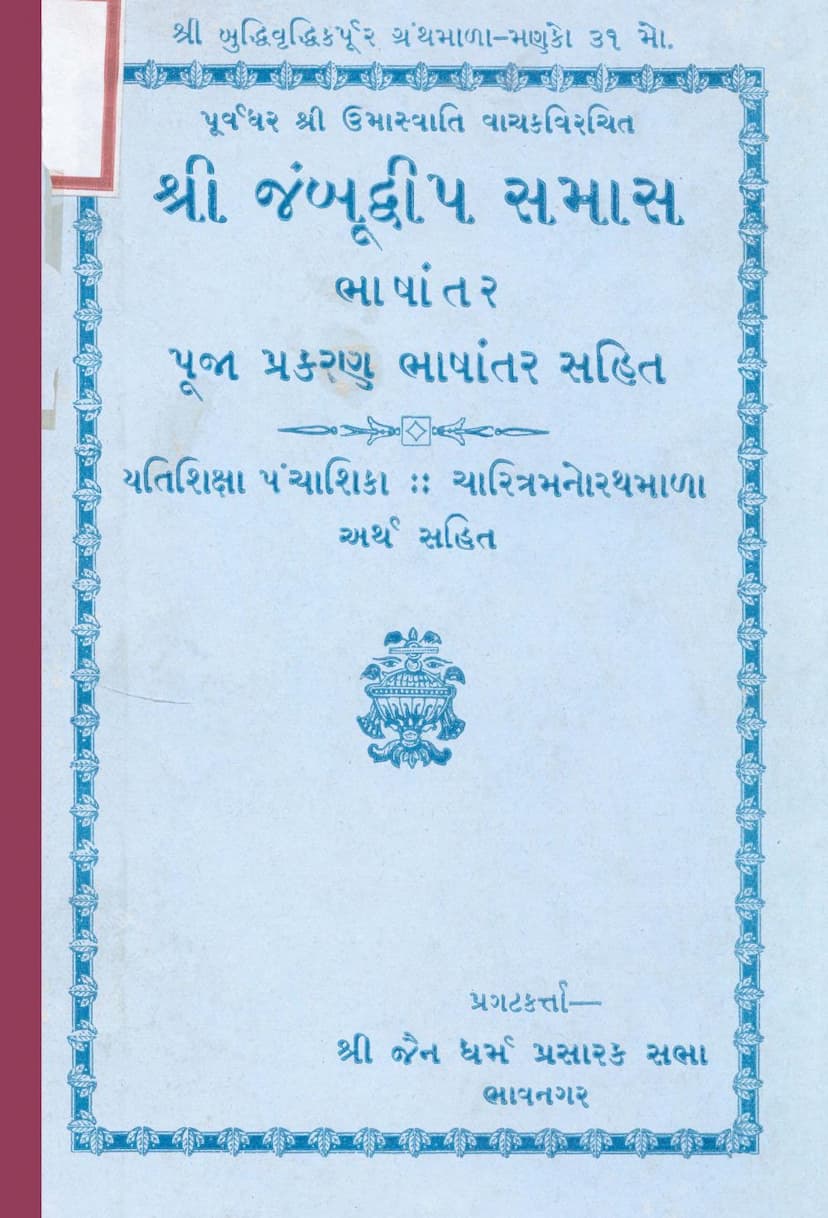Jambudwip Samas
Added to library: September 2, 2025

Summary
This comprehensive document is a Gujarati-language publication of the Jambudvīpa Samāsa (also known as Jambūdvīpa Samāsa) by the renowned Jain scholar Pūrvadhara Śrī Umāsvāti Vāchaka. The publication was brought out by the Śrī Jain Dharm Prasārak Sabhā, Bhavnagar, with the title "Śrī Jambudvīpa Samāsa" and includes Gujarati translations and explanations of other works by Umāsvāti, as well as related texts.
Here's a breakdown of the content:
Core Text:
- Jambudvīpa Samāsa: This is the primary focus of the book. It is a detailed Jain cosmological text that describes Jambudvīpa, the central continent of the Jain universe. The text meticulously details its geography, mountains, rivers, regions (kṣetras), the Meru mountain, and the celestial beings and structures associated with this continent. The provided text includes a substantial portion of the description of Jambudvīpa, starting with its general dimensions and then moving into descriptions of various geographical features and regions like:
- Bharat Kṣetra: The southern region of Jambudvīpa, described with its mountains (like Vijaya and Himavān), rivers (Ganga and Sindhu), cities (Ayodhya), and specific locations.
- Himavān Parvata: The description of the Himavān mountain, its dimensions, and associated features like lakes and waterfalls.
- Haimavata Kṣetra: The region north of Himavān.
- Mahāhimavān Parvata: The next major mountain range.
- Harivarṣa Kṣetra: Another region.
- Niṣadha Parvata: A significant mountain.
- Nilagiri Parvata: Another mountain.
- Ramya Kṣetra: A pleasant region.
- Samī Parvata: Another mountain.
- Haiṛanyavata Kṣetra: Another region.
- Śikharī Parvata: Another mountain.
- Airāvata Kṣetra: The northern region.
- Mahāvideha Kṣetra: The central and most important region, described with Mount Meru, its surrounding forests (Bhadrashala, Nandan, Samanasa, Pandaka), and the specific features of these regions. The description of Meru mountain is particularly detailed, covering its structure, layers, and surrounding elements.
- Description of other continents and oceans: The text also proceeds to describe the Lavana Samudra (Salt Ocean), Dhātakīkhaṇḍa (Dhātakī continent), Kālodadhi Samudra (Dark Ocean), Puṣkaravara (Pushkara continent), and the Mānuṣottara Parvata (Mānuṣottara Mountain), which marks the boundary of the human realm.
- Nandīśvara Dvīpa: A holy island with numerous temples, described as a place of worship for gods.
Additional Texts included:
The publication is not solely dedicated to the Jambudvīpa Samāsa. It also includes:
- Pūjā Prakaraṇa (with commentary): A section on the rituals and rules of worship, likely detailing the correct procedures and orientations for performing Jain worship. The commentary provides explanations for each verse.
- Dāna (Charity) – Eight Types (with commentary): A discussion on the eight types of charity as explained by Umāsvāti. The commentary elaborates on these classifications.
- Yatiśikṣā Pañchāśikā (with commentary): A collection of fifty verses offering guidance and instruction for ascetics (yati). The commentary explains the verses in detail.
- Cāritra Manoratha Mālā (with commentary): A series of thirty verses that express aspirations for good conduct and spiritual progress, with accompanying commentary.
Commentary and Editorials:
- Tīkākāra's (Commentator's) Preliminary Statement: This section introduces the work and the commentator's approach. It mentions that the text is based on various Jain scriptures like Jīvābhigama, Jambūdvīpa Prajñapti, and the commentary of Ācārya Śrī Jinabhadra Gaṇikṣamāśramaṇa. The commentator acknowledges the challenges of interpreting such a profound text due to their own limited knowledge.
- Tīkākāra's Final Statement: A concluding remark from the commentator, emphasizing the value of the work and requesting corrections from learned readers.
- Praise for the Commentator and Lineage: The text includes an elaborate praise of the lineage of scholars and spiritual leaders, tracing back through figures like Ācārya Śrī Vijayasiṁhasūri (or Śrī Vijayagūri), Śrī Abhayadevasūri, Śrī Dhanesvarasūri, Śrī Ajitasimha, and Śrī Bhadragupta. This section highlights the intellectual and spiritual prowess of these figures and their contribution to Jain scholarship.
- Introduction by the Publisher: The "Nivedan" (Introduction) by Kunvarji Anandji, the compiler and translator, explains the origin of this publication. It mentions receiving inspiration from a monk and highlights the effort involved in translating and compiling these texts, acknowledging potential errors due to the compiler's human limitations. He also expresses gratitude to those who helped in procuring manuscripts and providing commentary.
- Padas (Verses): The publication also includes some "padas" (verses) by Upadhyaya Śrī Yashovijayji and Śrī Chidanandji, likely devotional or philosophical poems.
Overall Purpose and Significance:
This publication aims to make the complex cosmological descriptions of Jambudvīpa and the ethical and practical guidance from other works of Umāsvāti accessible to a wider Jain audience through Gujarati translation. It serves as a valuable resource for understanding Jain cosmology, the life and teachings of ascetics, and the principles of Jain worship and ethics. The inclusion of detailed commentaries underscores the importance of these texts in Jain tradition and the scholarly effort dedicated to their preservation and dissemination.